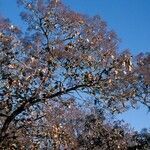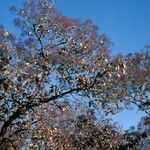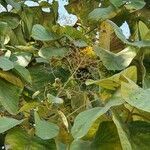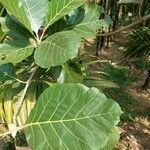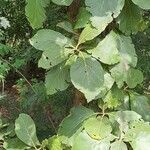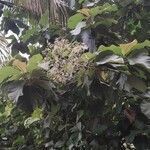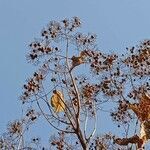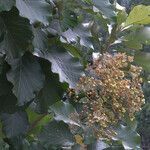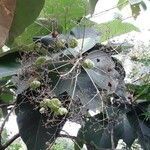Tree to 50 m tall; branches and branchlets stout, 4-sided, with large, quad-ran.gular pith, the younger parts usually with obtuse angles and drying more or less sulcate between the angles, densely furfuraceous-tomentose with cinereous or ochraceous tomentum; nodes distinctly annulate with usually a corky layer and denser tomentum. Leaves drooping, deciduous, with a clasping base; firmly chartaceous, broadly elliptic, (11-)23-55(-85) cm long (to 1 m on turoins) but (6-)22-37(-50) cm wide, apically acute or short-acuminate, entire or repand-denticulate, basally abruptly acute or long-acuminate and prolonged into the alate petiole or clasping at the base, dark-green and shiny above, much lighter and not shiny beneath, densely squamose and rugose or bullate above, glabrescent and becoming smooth, densely furfuraceous-tomentose beneath with ochraceous or reddish to brownish hairs and densely resinous-punctate; petioles short or wanting, more or less margined or alate, densely ochraceous-furfuraceous. Inflorescences in the uppermost leaf-axils and terminal, paniculate, massive, the terminal panicles often many decimeters long and wide, but mostly ca. 40 cm long and 35 cm wide with distant, opposite, widely divaricate, many-branched, many-flowered cymes, densely cinereous-or ochraceous-furfuraceous throughout; peduncles and sym-
It is a large tree at maturity, up to 50 m... Large elliptic leaves 10–100 cm. long, 5–50 cm. wide, mostly about 30 × 25 cm., stellate-tomentose beneath and often with red coloration on rubbing.. Inflorescences massive, ± 40 cm. long, 35 cm. wide with stellate-tomentose axes and small white flowers, the corolla-tube ± 1.5–3 mm. long.. Fruit subglobose, ± 1.5 cm. long and wide, enclosed in the inflated bladdery calyx 2.5 cm. long and wide.. Information on teak has been summarised by Krishna Murthy (Bibliography on teak, Dehra Dun, 1981) and Moldenke gives much information (Phytologia 1: 154–164 (1935) & 5: 112–120 (1954)).
A large tree. It grows 25-50 m tall. The trunk is 1 m across. It can have slight buttresses. It is open with many branches. It loses some leaves during the year. The leaves are oval and have a rough surface. They can be 60 cm long. The flowers are in large panicles. They are white or pink. The fruit is round and can have 4 seeds. These are oval and white.
